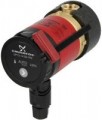Features
— Number of speeds. The number of speeds provided in the design of the pump. Each speed corresponds to its performance value (see above). The options could be:
- 1 speed. There are no adjustments in such models; when turned on, the pump can operate only at one speed. This is the simplest and most inexpensive option, due to the absence of additional elements (regulators) in the design. Of course, it is convenient only in cases where the unit must operate at full capacity every time it is turned on.
- 2 speeds. 2 speeds give the user some degree of choice: the pump does not have to be turned on at full power — when it is not required, the unit can be run at reduced power to save electricity and not wear out the mechanisms beyond what is necessary.
- 3 speeds. The largest number of adjustments found in modern pumps — it makes no sense to provide a larger number for many reasons. It gives even more options for setting operation parameters than 2 speeds.
- Stepless adjustment. This option implies the ability to set the regulator to any position from minimum to maximum (in some models, fixed settings may also be provided, but only as an additional option). It provides maximum freedom and precision in the choice of operating mode. However, it significantly affects the price; and the real need for smooth adjustment occurs quite rarely.
—
Automatic operating mode.... The essence of this function differs depending on the purpose of the device (see above). So, in models for increasing the pressure of cold water, the automation turns on the pump when the tap is opened and turns it off when it is closed — a special sensor reacts to the movement of water. In models for heating and domestic hot water, automation is responsible for adjusting the operating parameters — for example, when screwing the valves and reducing the flow rate, the pump can reduce the pressure, as well as, for additional functions, such as an on-off timer. Anyway, this feature makes life easier for the user, eliminating the need to perform certain operations manually and adding new features to the pump; but the specific set of these features depends on the model.
— Display. Various additional information can be displayed on the display: operating mode, performance settings, water temperature, set timers, error messages and much more. It makes management more convenient and intuitive. Pumps usually use the simplest form of black and white LCD screens, but this is quite sufficient for the purposes mentioned.
— Control panel. In this case, the control panel means a panel that has a switch with a choice of operating modes between automatic (see above) and manual. Accordingly, the presence of several modes almost necessarily means the presence of a control panel. But the speed switches themselves are not considered for this function.Max. power consumption
The electrical power consumed by the pump during normal operation and maximum performance.
This indicator directly depends on performance — after all, for pumping large volumes of water, an appropriate amount of energy is needed. And the power depends on two main parameters — electricity consumption and the load on the power grid, which determines the connection rules. For example, pumps with a power of more than 5 kW cannot be connected to ordinary household sockets; more detailed rules can be found in special sources.
Inlet
The size of the inlet provided in the design of the pump. For plumbing threads (see Connection), the size is traditionally indicated in inches and fractions of an inch (for example, 1" or 3/4"), for flanges, the nominal diameter (DN) of the bore in millimetres is used — for example, DN65.
This parameter must match the dimensions of the mount on the pipe to which the pump is planned to be connected — otherwise, you will have to use adapters, which is not very convenient, and sometimes not recommended at all.
Outlet
The size of the outlet provided in the design of the pump. The value of this parameter is completely similar to the size of the inlet (see above).
Impeller material
It is the material from which the impeller is made. It is the main part of the pump, which provides pressure due to movement.
—
Plastic. This material is inexpensive in itself, and it is easy to process, due to which it is distinguished by low cost. In addition, plastic is not subject to corrosion. On the other hand, it is considered the least reliable of all materials used in modern pumps and, therefore, is used in relatively inexpensive models that are not designed for serious loads. The exception to this rule are special high-strength polymers but they are rare.
—
Stainless steel. As the name suggests, stainless steel is virtually corrosion-resistant. However, this is not its only advantage — this material is very durable and reliable, and due to this, it is used even in powerful high-performance models.
—
Cast iron. This material is in many ways similar to steel — in particular, it is considered very reliable — but it has a slightly higher weight. On the other hand, in most cases, this is not a noticeable drawback, but cast iron costs a little cheaper than stainless steel.
—
Brass. An alloy based on copper and zinc which has a golden colour. The varieties used in circulation pumps are highly resistant to corrosion, they surpass even stainless steel. Therefore, this option is well suited for
...water with a high oxygen content. The disadvantage of brass can be called a rather high cost.Port-to-port length
The installation length is the distance between the inlet and outlet of the pump, in other words, the length of the segment occupied by the pump in the circuit. This parameter allows you to estimate the amount of space required for the unit, and determine the length of the pipe section that needs to be cut.

